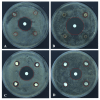New Species, New Record, and Antagonistic Potential of Torula (Torulaceae, Pleosporales) from Jilin Province, China
- PMID: 40731969
- PMCID: PMC12300790
- DOI: 10.3390/microorganisms13071459
New Species, New Record, and Antagonistic Potential of Torula (Torulaceae, Pleosporales) from Jilin Province, China
Abstract
During a survey of ascomycetous fungi associated with plant litter and submerged wood in Jilin Province, China, two hyphomycetous fungi were discovered. Morphological examination and molecular phylogenetic analyses revealed that these isolates represent two species within the genus Torula, which are herein described as Torula changchunensis sp. nov. and a new host record of T. mackenziei. Detailed morphological characteristics are provided, and the phylogenetic relationships of the new species are also discussed. The new species differs from T. chinensis and T. phytolaccae by having smaller conidiogenous cells, smaller conidia, and fewer septa. Preliminary assessments were conducted on T. changchunensis and T. mackenziei to evaluate their antagonistic activity against two pathogenic fungi (Cladobotryum mycophilum and Botrytis cinerea) and two pathogenic bacteria (Staphylococcus aureus and Bacillus subtilis). Torula changchunensis sp. nov. exhibited 67.18% inhibition against C. mycophilum and moderate inhibition against the pathogenic bacteria, whereas Torula mackenziei showed moderate-to-weak inhibitory activity against both pathogenic fungi and bacteria.
Keywords: antifungal activity; hyphomycetous fungi; northeastern China; phylogeny; taxonomy.
Conflict of interest statement
The authors declare no conflicts of interest.
Figures





Similar articles
-
Diaporthe species on palms - integrative taxonomic approach for species boundaries delimitation in the genus Diaporthe, with the description of D. pygmaeae sp. nov.Stud Mycol. 2024 Dec;109:487-594. doi: 10.3114/sim.2024.109.08. Epub 2024 Oct 23. Stud Mycol. 2024. PMID: 39717652 Free PMC article.
-
Identification and biological characteristics of Fusarium tobaccum sp. nov., a novel species causing tobacco root rot in Jilin Province, China.Microbiol Spectr. 2024 Nov 14;12(12):e0092524. doi: 10.1128/spectrum.00925-24. Online ahead of print. Microbiol Spectr. 2024. PMID: 39540755 Free PMC article.
-
The overlooked amoebae of an agroecosystem of black soil land in China: five new species of dictyostelids.Appl Environ Microbiol. 2025 Jul 23;91(7):e0002525. doi: 10.1128/aem.00025-25. Epub 2025 Jun 10. Appl Environ Microbiol. 2025. PMID: 40492701 Free PMC article.
-
Falls prevention interventions for community-dwelling older adults: systematic review and meta-analysis of benefits, harms, and patient values and preferences.Syst Rev. 2024 Nov 26;13(1):289. doi: 10.1186/s13643-024-02681-3. Syst Rev. 2024. PMID: 39593159 Free PMC article.
-
The Black Book of Psychotropic Dosing and Monitoring.Psychopharmacol Bull. 2024 Jul 8;54(3):8-59. Psychopharmacol Bull. 2024. PMID: 38993656 Free PMC article. Review.
References
-
- Sturm J. Deutschlands Flora Abt III. Die Pilze Deutschlands; Nuremberg, Germany: 1829.
-
- Manawasinghe I.S., Calabon M.S., Jones E.B.G., Zhang Y.X., Liao C.F., Xiong Y.R., Chaiwan N., Kularathnage N.D., Liu N.G., Tang S.M., et al. Mycosphere notes 345–386. Mycosphere. 2022;13:454–557. doi: 10.5943/mycosphere/13/1/3. - DOI
-
- Hyde K.D., Hongsanan S., Jeewon R., Bhat D.J., McKenzie E.H.C., Jones E.B.G., Phookamsak R., Ariyawansa H.A., Boonmee S., Zhao Q., et al. Fungal diversity notes 367–490: Taxonomic and phylogenetic contributions to fungal taxa. Fungal Divers. 2016;80:1–270. doi: 10.1007/s13225-016-0373-x. - DOI
-
- Su X.J., Luo Z.L., Jeewon R., Bhat D.J., Bao D.F., Li W.L., Hao Y.E., Su H.Y., Hyde K.D. Morphology and multigene phylogeny reveal new genus and species of Torulaceae from freshwater habitats in northwestern Yunnan, China. Mycol. Prog. 2018;17:531–545. doi: 10.1007/s11557-018-1388-3. - DOI
Grants and funding
LinkOut - more resources
Full Text Sources

